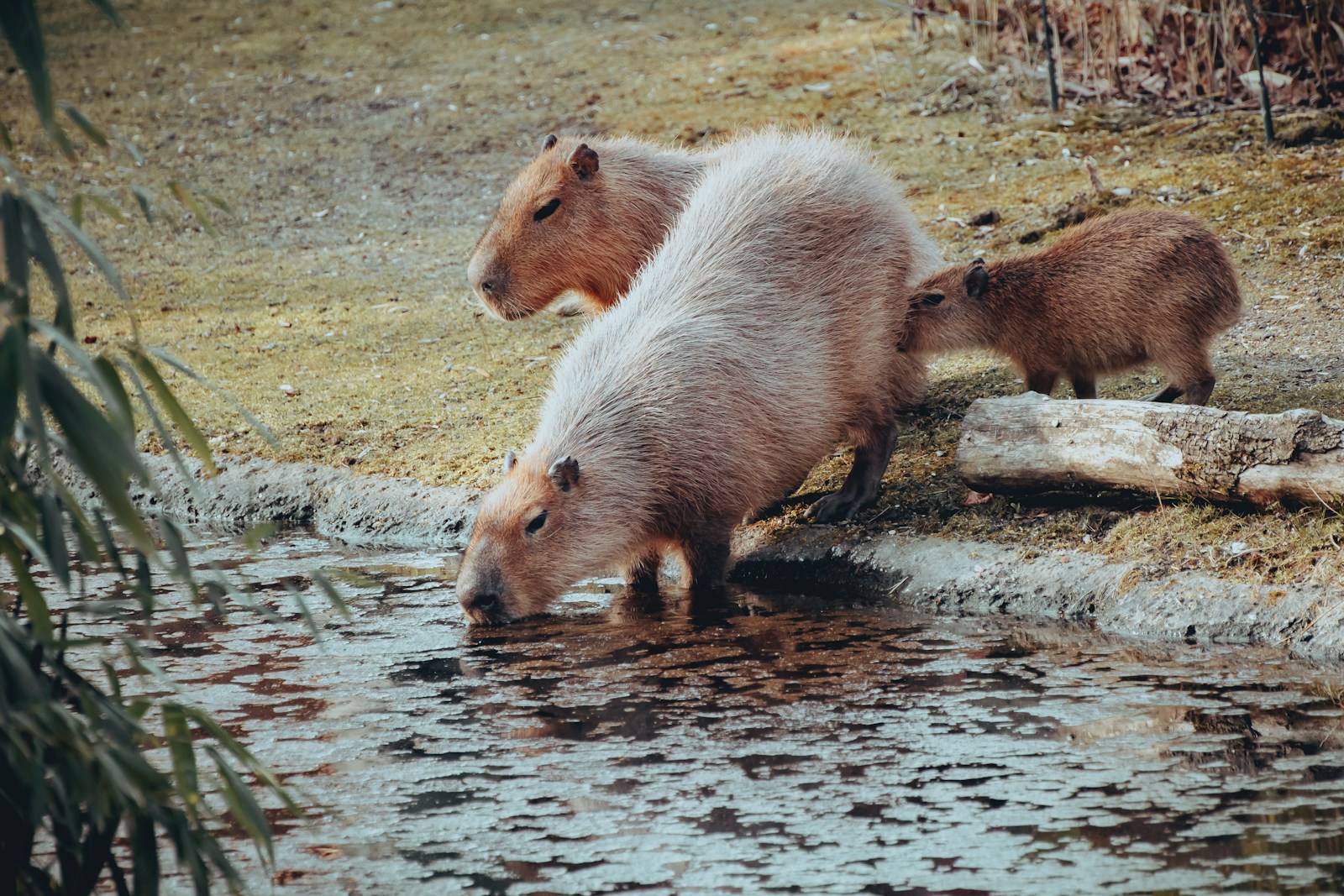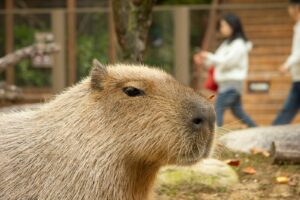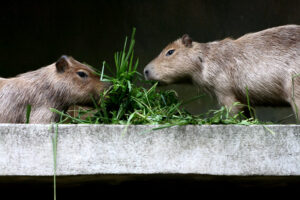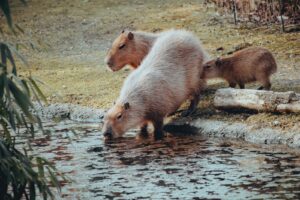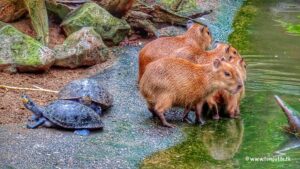These adorable creatures are the largest rodents in the world and are known for their friendly and gentle nature. With their round bodies, short legs, and webbed feet, capybaras are perfectly adapted for a semi-aquatic lifestyle. Let’s dive into some interesting capybara facts that will captivate the imaginations of kids and adults alike. From their love for water and swimming abilities to their social behavior and unique features, capybaras are truly fascinating animals.
Physical Characteristics of Capybaras
Capybaras have a unique set of physical characteristics that make them stand out among other animals. They have a large, barrel-shaped body covered in short, coarse hair that ranges in color from brown to reddish-brown. Their heads are small and round, with small ears and eyes located on the top of their head, allowing them to keep an eye out for predators while staying partially submerged in the water.
One of the most striking features of capybaras is their webbed feet. These webbed feet are perfectly adapted for a semi-aquatic lifestyle, allowing them to swim effortlessly through the water. Capybaras also have powerful jaws and sharp front teeth, which they use to chew through tough plants and grasses. Their teeth are continually growing, so they need to constantly chew to keep them in check.
Capybaras are not only the largest rodents in the world but also the heaviest. They can grow up to 4.5 feet in length and weigh between 77 and 146 pounds. Despite their size, capybaras are surprisingly agile and can run at speeds of up to 22 miles per hour, making them capable of escaping predators.
Habitat and Distribution of Capybaras
Capybaras are native to South America and can be found in a variety of habitats, including savannas, marshes, and rainforests. They are most commonly found near bodies of water, such as rivers, lakes, and ponds, as they rely on water for survival. Capybaras are excellent swimmers and spend a significant amount of time in the water to regulate their body temperature and avoid predators.
These fascinating creatures are found in several countries in South America, including Brazil, Argentina, Colombia, Venezuela, and Paraguay. They are well adapted to the tropical and subtropical climates of these regions and can thrive in both wet and dry environments.
Behavior and Social Structure of Capybaras
Capybaras are highly social animals and live in large family groups known as “herds.” These herds can consist of anywhere from 10 to 40 individuals, creating a tight-knit community. Within the herd, there is a dominant male, known as the alpha male, who leads and protects the group.
Capybaras are known for their peaceful nature and rarely exhibit aggression towards each other. They are herbivores and spend a significant amount of time grazing on grasses and aquatic plants. Despite their gentle nature, capybaras are territorial animals and mark their territory by rubbing their scent glands on objects within their habitat.
Capybaras are also highly vocal animals and communicate with a variety of vocalizations, including barks, whistles, and purrs. These vocalizations allow them to communicate with other members of their herd and help establish social bonds.
Diet and Feeding Habits of Capybaras
As herbivores, capybaras have a diet consisting mainly of grasses, aquatic plants, and fruits. They have a unique digestive system that allows them to extract nutrients from cellulose-rich plant material. Capybaras have a large cecum, which acts as a fermentation chamber and helps break down tough plant fibers.
To meet their nutritional needs, capybaras spend a significant amount of time grazing on grasses and aquatic plants. They also have specialized teeth that are adapted for chewing through tough plant material. Capybaras are known to eat a variety of plants, including reeds, water hyacinths, and even crops such as rice and sugarcane.
Capybaras are crepuscular animals, which means they are most active during the early morning and late afternoon. During these times, they can be seen grazing and foraging for food near bodies of water. They have a slow metabolic rate and can survive on a diet consisting mainly of low-energy plant material.
Reproduction and Lifecycle of Capybaras
Capybaras have a unique reproductive system and can have multiple breeding seasons throughout the year. The females, known as sows, have a gestation period of around 150 days and give birth to a litter of 2 to 8 pups, although the average litter size is around 4 to 5 pups.
After birth, the capybara pups are fully developed and can walk and swim within hours. They rely on their mothers for protection and nourishment during their early stages of life. The pups are weaned at around 3 months old but will continue to stay with their mother and the rest of the herd for up to a year before becoming independent.
Capybaras have a relatively long lifespan compared to other rodents, with some individuals living up to 12 years in the wild. However, they face several threats in their environment that can impact their survival, including habitat loss, hunting, and predation.

Predators and Threats to Capybaras
While capybaras are large in size, they are not without predators. They are preyed upon by a variety of animals, including jaguars, anacondas, caimans, and large birds of prey. Capybaras rely on their keen senses and agility to evade predators, often seeking refuge in the water when threatened.
Habitat loss is one of the biggest threats facing capybaras. As human populations expand and encroach upon their natural habitats, capybaras are losing their homes and food sources. Deforestation, urbanization, and agricultural expansion are all contributing factors to the decline of capybara populations.
Additionally, capybaras are hunted for their meat and hide in some regions. While hunting capybaras is illegal in many countries, there is still a demand for their products in certain areas. Conservation efforts are crucial to protect capybaras and ensure their survival for future generations.
Fun Facts about Capybaras
- Excellent Swimmers: Capybaras can stay submerged underwater for up to five minutes. Their webbed feet and streamlined bodies allow them to move effortlessly through the water.
- Social Grooming: Capybaras often engage in mutual grooming to strengthen their social bonds. They use their incisors to groom each other and remove parasites from their fur.
- Coprophagy: Despite being herbivores, capybaras occasionally eat their own feces. This behavior helps them gain additional nutrients that were not fully digested the first time.
- Vocal Communication: Capybaras use a variety of vocalizations to express their emotions, alert others to danger, or communicate their dominance within the herd.
- Symbiotic Relationships: Certain bird species, known as “capybara birds,” perch on the backs of capybaras and feed on parasites found in their fur, providing a cleaning service for the capybaras.
Capybaras as Pets
Due to their gentle nature and sociability, capybaras have gained popularity as pets in some countries. However, owning a capybara as a pet comes with its challenges and responsibilities. Capybaras require a large, secure enclosure with access to water for swimming and grazing areas for foraging.
Capybaras also need a specialized diet consisting of fresh grasses, vegetables, and fruits. They require regular veterinary care, including vaccinations and check-ups, to ensure their health and well-being. It’s important to note that in some regions, owning a capybara as a pet may be illegal or require special permits.
Conclusion: Why Capybaras are Fascinating Animals for Kids
Capybaras are truly fascinating animals that captivate the imaginations of kids and adults alike. From their unique physical characteristics, such as webbed feet and barrel-shaped bodies, to their social behavior and love for water, capybaras are a wonder to behold.
These gentle giants live in large family groups and communicate through a variety of vocalizations. They have a specialized diet and spend a significant amount of time grazing on grasses and aquatic plants. Capybaras are also remarkable swimmers and can stay submerged underwater for up to five minutes.
While capybaras face threats in their natural habitat, they continue to inspire awe and admiration. Their peaceful nature and ability to coexist in large herds serve as a valuable lesson in cooperation and community.
So, whether you’re a young animal enthusiast or just curious about these intriguing creatures, the world of capybaras is waiting to be explored. Dive into their fascinating world and discover why capybaras are worthy of our admiration and respect.
Sources
- National Geographic. (n.d.). Capybara. Retrieved from National Geographic
- San Diego Zoo. (n.d.). Capybara. Retrieved from San Diego Zoo
- The Rainforest Foundation. (n.d.). Capybara. Retrieved from The Rainforest Foundation
